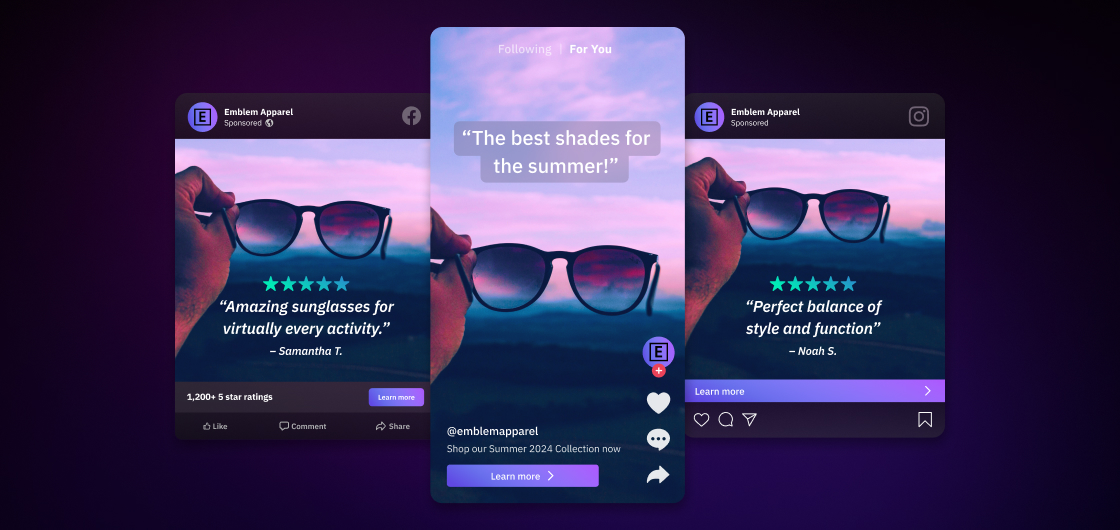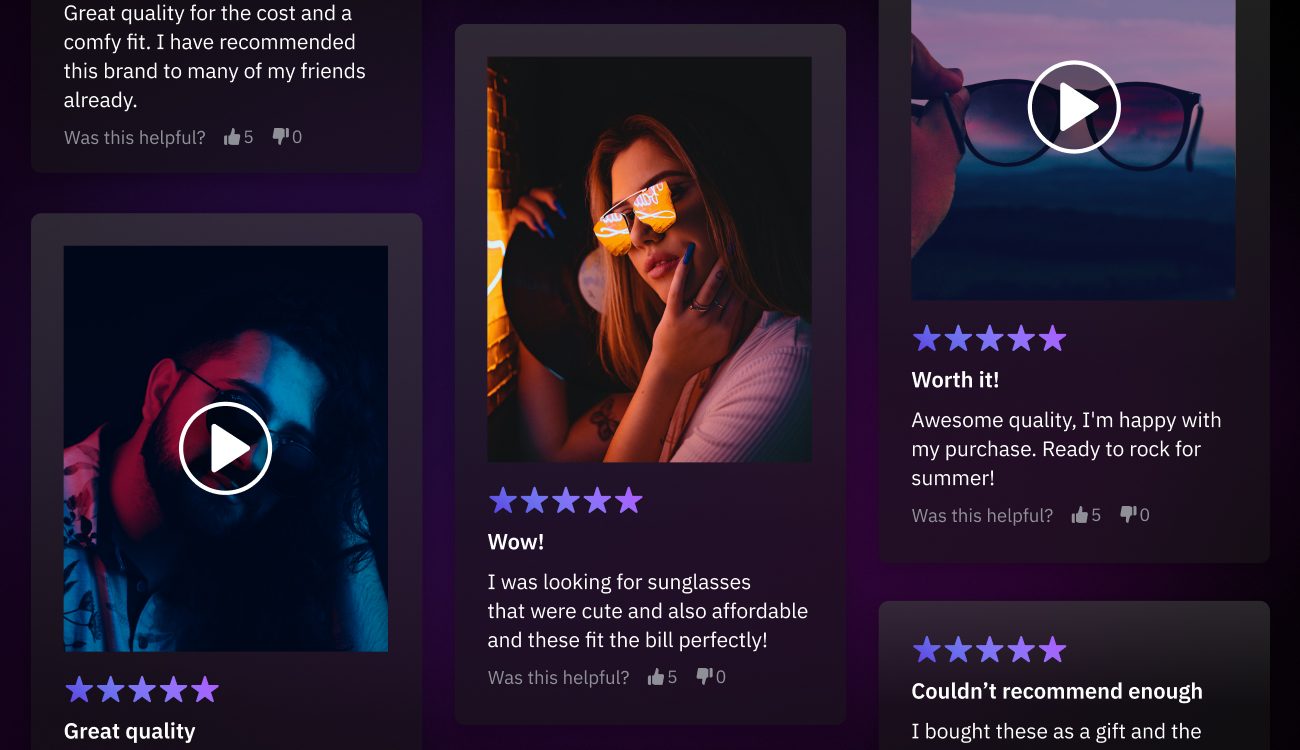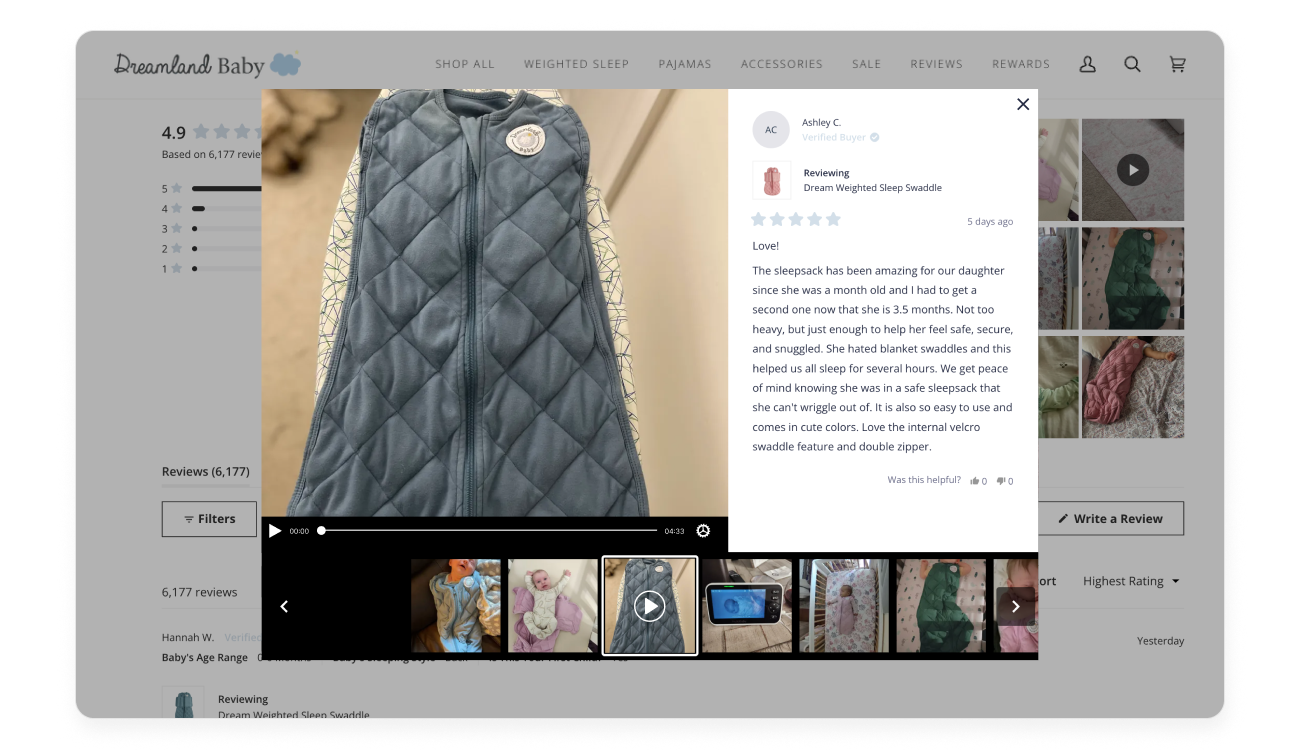What is Testimonial Advertising? Types, Benefits & Examples

Testimonial advertising uses existing customers’ positive experiences to promote your product, building trust and credibility. By showcasing relatable and authentic feedback, you can enhance your brand reputation and attract new customers. Implement various forms like written reviews, video testimonials, celebrity and expert endorsements, and user-generated content to create effective and genuine ads. For best results, keep testimonials concise, highlight specific benefits, and maintain authenticity. Okendo can streamline this process, ensuring a seamless collection and compelling display of customer feedback to boost your brand’s growth.
Of the many forms advertising takes in the modern ecommerce landscape, few are as personable, credible, and cost-effective as testimonial advertising. Testimonial advertising is the employment of existing customers’ testimonies or experiences with a product or service for the purpose of marketing to new customers. Its goal is to convince target customers of a product’s effectiveness or quality by showcasing the positive experiences or opinions other customers have regarding the product.
Explained: What is Testimonial Advertising?
Testimonial advertising is especially effective in generating brand trust and reputation. Understandably so, customers are far more likely to trust the opinions of existing customers rather than the claims of a paid ad or sponsorship. If previous customers have had a positive interaction or experience with your brand or product and can vouch for its quality, new customers would assume that their experience would be just as positive.
Testimonial advertising, when used effectively, can also add a personable or relatable touch to advertisements. When brands utilize unedited reactions from customers, advertisements read as more genuine and trustworthy and less scripted or calculated. Put simply, the authenticity of the brand is on display.
Testimonial advertising has the added benefit of providing your brand with valuable and direct feedback to help improve your products and services. While you might use positive customer testimonies for advertisement, you might also use negative customer testimonies as a roadmap for improvement and to direct your efforts in addressing the concerns that matter the most to your customers.
Why Testimonial Advertising is Effective
Customers are likely to trust, believe, and relate to the experiences of another customer, especially if it is clear that the other customer was not paid or required to share a testimony. The thinking is along the lines of, “If it worked for them, it will work for me” and “It must be true if this customer was not paid or incentivized.” Four reasons can summarize testimonial advertising’s effectiveness and its impacts:
- Relatability: Customer testimonies are effective in that they are relatable. Customers seek out opinions from others who are similar or have something in common with them. In this sense, testimonies from regular people are much more relatable than those from a sponsored celebrity or paid model.
- Specificity: Since testimonies often focus on what the customer finds important when reviewing or summarizing an experience with your brand, they are much more specific and applicable to real concerns other customers would have. In a paid ad, you might not speak to a clothing item’s size or fit for example, but a customer testimony might focus on how a clothing item fits true to size and address other customers’ valid concerns regarding fit.
- Herd Mentality: Testimonial advertising has a tendency to create virality through herd mentality. Oftentimes brands display review counts to make use of the effects of power in numbers. Showing that not just one customer, but many customers have purchased and had positive experiences with a product or service provides confidence that future customers will have a similar experience.
- Confidence: Yes, customer testimonies create confidence in your brand’s product or service, but also in the brand itself. Displaying or employing authentic and unedited testimonies from real customers shows that you value customer feedback and are committed to creating positive experiences. This can have a big influence on the consumer decision making process, making them more likely to make a purchase.
Different Types of Testimonial Advertising with Examples
Okendo supports different forms of testimonial advertising. Your brand can utilize them to create an effective and well-rounded testimonial advertising strategy that will instill confidence in your customers and build brand trust.
1. Customer Testimonials
Customer testimonials also known as customer reviews, are opinions, feedback, reviews, or comments directly from the customer. They are often attributed to a specific product or to the brand as a whole.
The most common form is a written review. Brands often display these on ecommerce site PDPs to share what customers think of a specific product. Depending on the prompt, customers can write very short-form reviews with a few words on whether they liked or did not like the product, or more long-form reviews with a detailed account of their experience with the product.

Recently, more customer testimonials have shifted to video format, with customers posting their opinions on social media and brand websites. These can be useful in showing an experience with a product, thereby adding a layer of credibility to the testimony. The drawback with video testimonials is that they are often more long-form and require more time for the potential customer to digest than a written testimony.
2. User-Generated Content
User-Generated Content (UGC) involves customers posting a photo or video of the product to supplement their review and provide greater visual insights into their experience. It is often posted on either social media or on PDPs in the reviews section. The benefits of UGC are two-fold: if the quality and message align with your brand standards, you can use it for visual advertisements. This results in personable, genuine, and believable advertising with little to no production costs.
Written vs Video Testimonials: Which Works Better?
When evaluating your testimonial advertising strategy, the question of how much to incorporate written or video testimonials is likely to come up. While each format has its benefits, a keen understanding of how customers shop or refer to testimonials will be necessary when deciding between the two.
Written testimonials are more universal and have fewer barriers to completion meaning they can be collected at scale. Video testimonials on the other hand are much more difficult to create but are possibly more effective in explaining and showcasing the benefits of a particular product.
To decide between both formats or concentrate your efforts on one over the other, consider whether your product category warrants a more detailed or visual explanation. If the product is straightforward and without many nuances, consider sticking to written testimonials for ease of collection. If the product category is complicated and would benefit from a visual review, try to incorporate video testimonials where possible.
Pros and Cons of Written Testimonials
| Written Testimonials | Video Testimonials |
| Benefits
Easy to collect Quick to read Easily digested Shortform Quantifiable |
Benefits
More personable Interactive More engaging Conducive to social media More visual Longform More believable |
| Drawbacks
Less detailed Lower quality content Requires reading Not as conducive to social media Less visual Less believable |
Drawbacks
Greater time commitment Difficult to collect Difficult to produce |
An Effective Testimonial Advertising Example: Dreamland Baby
Dreamland Baby is a successful online brand that produces weighted baby swaddles and blankets to help babies (and their parents) sleep soundly through the night. The brand understood that in order to be successful in their product vertical, they needed to make use of customer testimonies. In the baby products sphere, customers are more than willing to share their experiences, and customer testimonials often take the form of parenting tips and hacks in order to help out the next generation of new, sleep-deprived parents.
Dreamland Baby used Okendo Reviews to help create customer testimonial campaigns, build brand trust, and foster brand awareness and virality in their customer acquisition strategies. By leveraging Okendo’s integration with Klaviyo to solicit feedback on their products, Dreamland Baby successfully collected customer testimonials, harvested third-party data from the customizable review form, and incentivized visual UGC (both photo and video) to enhance the quality and information within their testimonials.

After successfully collecting customer testimonies and adding context with videos, photos, and third-party data, Dreamland Baby was able to incorporate social proof into their campaigns for effective testimonial advertising. At different touchpoints, Dreamland Baby would refer to star ratings, quotes from product reviews, UGC, and quantifiable data to create trusted and credible ads that come across as a genuine “parenting tip” rather than a sponsored ad thereby adding a touch of authenticity.
Key Tips for Creating Compelling Testimonial Ads
Creating engaging testimonial ads requires some strategic forethought not only in the collection of testimonies but also in the use or deployment of the collected testimonies. For an effective ad campaign, ensure that your testimonies are authentic, credible, and specific without compromising brevity.
Choose Authentic Testimonials
The key to successful testimonial advertising is to showcase authentic and believable testimonies. An exaggerated or salesman-like testimony would defeat the purpose and genuineness of collecting testimonies from real, relatable customers.
For this reason, be sure to disclose whether testimonies were sponsored and always provide an option for sharing a negative experience. While it might seem counterintuitive, displaying negative reviews can show that your brand cares about transparency and enhance the believability and effectiveness of the positive reviews.
Highlight Benefits and Results
When choosing customer testimonies to showcase, be sure to use reviews that are accurate to the product and that are specific in highlighting its features and benefits. For example, while a review written in all caps with several exclamation points (“I LOVE THIS PRODUCT!”) might be enthusiastic and attention-grabbing, a review that speaks to the quality, fit, features, and details of the product (“This product fits true to size, is high quality, and was very comfortable for my event”) will be far more effective.
Keep it Concise and Engaging
It can be tempting to feature a review that prattles on about your products, but with limited attention spans and a focus on convenience, getting to the point will be more effective in your testimonial advertising efforts.
Consider abbreviating or shortening your customer testimonies depending on your ad campaigns and keep the touchpoint in mind for how short your content needs to be. A blog post could handle a longer review, but a paid social media ad would only be able to handle a few words (and those few words will need to be convincing).
How to Ask for Testimonials from Customers
When requesting testimonials from customers, it is important to keep the format flexible, convenient, and seamless. Customers who are willing to take the time to review a product are rare, and brands should consider the process and how to make it as friction-free as possible.
To ask for a testimonial, use a combination of open fields and preset selections for added convenience and to enhance the context of the testimony. For example, a clothing brand might use an open field to ask customers for their opinions and encourage a freeform written response and then also use an attribute selector for customers to indicate how the product fits (runs small, true to size, runs large). This adds context for future customers, highlights an important feature of the product, and creates a more convenient and easy-to-use testimony form for the reviewing customer.
You should also ensure that the customers have adequate time to evaluate the product with an informed opinion before soliciting a review. This will improve the quality of your testimonies and allow for more valuable feedback on how to improve if necessary.

Leverage Testimonial Advertising with Okendo
Okendo can help your brand streamline review collection, showcase social proof, enhance testimonies with UGC, and create effective and authentic testimonial ad campaigns. Okendo Reviews offers brands an intuitive and user-friendly way to display customer testimonials at different points in the shopping funnel and showcase UGC for added context, better digestibility, and more compelling advertisements.
Check out Okendo Reviews and book a demo call to start leveraging testimonies in new fresh and authentic advertising formats.
Conclusion
Customer testimonies not only serve as an excellent source of feedback and direction for improvement but also as social proof for testimonial advertisements. Testimonial advertisements create brand trust, foster loyalty, optimize conversion rates, and take advantage of herd mentality in convincing new customers of your product’s quality and effectiveness. Consider testimonial advertising for your next ad campaign and experience the benefits that authentic feedback can have on your brand’s online growth.
FAQs
What is a testimonial in advertising?
Testimonial advertising is a form of advertising that involves using customer testimonials to vouch for the effectiveness, quality, or benefits of a product. It uses quotes, ratings, feedback, or UGC from existing customers to entice or convince potential customers to make a purchase.
Why are testimonials used in marketing?
Testimonials are used in marketing to add credibility and trustworthiness to an ad campaign. Whereas potential customers might be skeptical of a brand’s ads or claims about the benefits of a product, a testimony from a real and satisfied customer appears more believable thereby instilling trust in future customers.
What is the most effective type of testimonial advertising?
The most effective type of testimonial advertising will depend on the product category. For some product categories, a simple written review or rating would suffice, but with more complicated or big-ticket product categories, customers might require more videos, images, or other forms of UGC to reduce skepticism.
How do you get started with testimonial advertising?
Get started with testimonial advertising by first requesting testimonies from customers. After collecting sufficient social proof, you can begin experimenting with ad formats and use customer quotes or ratings in email newsletters, blogs, social media posts, or other forms of paid advertisements.